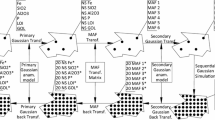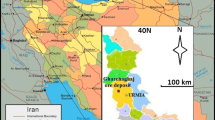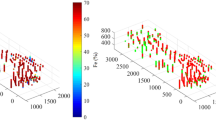Abstract
Spatial uncertainty analysis is a complex and difficult task for orebody estimation in the mining industry. Conventional models (kriging and its variants) with variogram-based statistics fail to capture the spatial complexity of an orebody. Due to this, the grade and tonnage are incorrectly estimated resulting in inaccurate mine plans, which lead to costly financial decision. Multiple-point geostatistical simulation model can overcome the limitations of the conventional two-point spatial models. In this study, a multiple-point geostatistical method, namely SNESIM, was applied to generate multiple equiprobable orebody models for a copper deposit in Africa, and it helped to analyze the uncertainty of ore tonnage of the deposit. The grade uncertainty was evaluated by sequential Gaussian simulation within each equiprobable orebody models. The results were validated by reproducing the marginal distribution and two- and three-point statistics. The results show that deviations of volume of the simulated orebody models vary from − 3 to 5% compared to the training image. The grade simulation results demonstrated that the average grades from the different simulation are varied from 3.77 to 4.92% and average grade 4.33%. The results also show that the volume and grade uncertainty model overestimates the orebody volume as compared to the conventional orebody. This study demonstrates that incorporating grade and volume uncertainty leads to significant changes in resource estimates.














Similar content being viewed by others
References
Abutaleb, A. S. (1989). Automatic thresholding of gray-level pictures using two-dimensional entropy. Computer Vision, Graphics, and Image Processing, 47(1), 22–32.
Allard, D., D’Or, D., Biver, P., & Froidevaux, R. (2012). Non-parametric diagrams for plurigaussian simulations of lithologies. In 9th International Geostatistical Congress, Oslo, Norway (p. 1115).
Arpat, G. B. (2005). Sequential simulation with patterns. Ph.D. Thesis, Stanford University.
Arpat, G. B., & Caers, J. (2007). Conditional simulation with patterns. Mathematical Geology, 39(2), 177–203.
Bastante, F. G., Ordóñez, C., Taboada, J., & Matías, J. M. (2008). Comparison of indicator kriging, conditional indicator simulation and multiple-point statistics used to model slate deposits. Engineering Geology, 98(1), 50–59.
Betzhold, J., & Roth, C. (2000). Characterizing the mineralogical variability of a Chilean copper deposit using plurigaussian simulations. Journal of South African Institute of Mining and Metallurgy, 100(2), 111–120.
Beucher, H., Galli, A., Le Loc’h, G., & Ravenne, C. (1993). Including a regional trend in reservoir modelling using the truncated gaussian method. In A. Soares (Ed.), Geostatistics Tróia’92 (Vol. 1, pp. 555–566). Dordrecht: Springer.
Camus, J. P. (2002). Management of mineral resources: Creating value in the mining business. Littleton: SME.
Chatterjee, S., Dimitrakopoulos, R., & Mustapha, H. (2012). Dimensional reduction of pattern-based simulation using wavelet analysis. Mathematical Geosciences, 44(3), 343–374.
Chatterjee, S., Mustapha, H., & Dimitrakopoulos, R. (2016). Fast wavelet-based stochastic simulation using training images. Computational Geosciences, 20(3), 399–420.
Deutsch, C. V., & Journel, A. G. (1998). GSLIB: Geostatistical software library. New York: Oxford University Press.
Dimitrakopoulos, R., Farrelly, C. T., & Godoy, M. (2002). Moving forward from traditional optimization: Grade uncertainty and risk effects in open-pit design. Mining Technology, 111(1), 82–88.
Dimitrakopoulos, R., & Godoy, M. (2014). Grade control based on economic ore/waste classification functions and stochastic simulations: Examples, comparisons and applications. Mining Technology, 123(2), 90–106.
Dowd, P. A. (1994). Risk assessment in reserve estimation and open-pit planning. Transactions of the Institution of Mining and Metallurgy (Section A: Mining Industry), 103, A148–A154.
Dowd, P. A., Xu, C., Mardia, K. V., & Fowell, R. J. (2007). A comparison of methods for the stochastic simulation of rock fractures. Mathematical Geology, 39(7), 697–714.
Emery, X. (2004). Properties and limitations of sequential indicator simulation. Stochastic Environmental Research and Risk Assessment, 18(6), 414–424.
Emery, X. (2007). Simulation of geological domains using the plurigaussian model: New developments and computer programs. Computers & Geosciences, 33(9), 1189–1201.
Emery, X., Ortiz, J. M., & Rodríguez, J. J. (2006). Quantifying uncertainty in mineral resources by use of classification schemes and conditional simulations. Mathematical Geology, 38(4), 445–464.
Goodfellow, R., Consuegra, F. A., Dimitrakopoulos, R., & Lloyd, T. (2012). Quantifying multi-element and volumetric uncertainty, Coleman McCreedy deposit, Ontario, Canada. Computers & Geosciences, 42, 71–78.
Goovaerts, P. (1997). Geostatistics for natural resources evaluation. New York: Oxford University Press on Demand.
Guardiano, F. B., & Srivastava, R. M. (1993). Multivariate geostatistics: Beyond bivariate moments. In A. Soares (Ed.), Geostatistics Tróia’92 (Vol. 1, pp. 133–144). Dordrecht: Springer.
Honarkhah, M., & Caers, J. (2010). Stochastic simulation of patterns using distance-based pattern modeling. Mathematical Geosciences, 42(5), 487–517.
Huang, T., Lu, D.-T., Li, X., & Wang, L. (2013). GPU-based SNESIM implementation for multiple-point statistical simulation. Computers & Geosciences, 54, 75–87.
Isaaks, E. H., & Srivastava, R. M. (1989). Applied geostatistics (p. 561). New York: Oxford University Press.
Liu, Y. (2006). Using the Snesim program for multiple-point statistical simulation. Computers & Geosciences, 32(10), 1544–1563.
Maleki, M., & Emery, X. (2015). Joint simulation of grade and rock type in a stratabound copper deposit. Mathematical Geosciences, 47(4), 471–495.
Mariethoz, G., & Renard, P. (2010). Reconstruction of incomplete data sets or images using direct sampling. Mathematical Geosciences, 42(3), 245–268.
Mustapha, H., Chatterjee, S., & Dimitrakopoulos, R. (2014). CDFSIM: Efficient stochastic simulation through decomposition of cumulative distribution functions of transformed spatial patterns. Mathematical Geosciences, 46(1), 95–123.
Mustapha, H., & Dimitrakopoulos, R. (2010a). High-order stochastic simulation of complex spatially distributed natural phenomena. Mathematical Geosciences, 42(5), 457–485.
Mustapha, H., & Dimitrakopoulos, R. (2010b). A new approach for geological pattern recognition using high-order spatial cumulants. Computers & Geosciences, 36(3), 313–334.
Ortiz, J. M., & Emery, X. (2006). Geostatistical estimation of mineral resources with soft geological boundaries: A comparative study. Journal of the South African Institute of Mining and Metallurgy, 106(8), 577–584.
Osterholt, V., & Dimitrakopoulos, R. (2007). Simulation of wireframes and geometric features with multiple-point techniques: Application at Yandi iron ore deposit. Orebody Modelling and Strategic Mine Planning, AusIMM, Spectrum Series, 14, 95–124.
Pyrcz, M. J., & Deutsch, C. V. (2014). Geostatistical reservoir modeling. New York: Oxford University Press.
Rendu, J.-M. (2002). Geostatistical simulations for risk assessment and decision making: The mining industry perspective. International Journal of Surface Mining, Reclamation, and Environment, 16(2), 122–133.
Riquelme, R., Le Loc’h, G., & Carrasco, P. (2008). Truncated Gaussian and plurigaussian simulations of lithological units in Mansa Mina deposit. In J. M. Ortiz & X. Emery (Eds.), Proceedings of the 8th International Geostatistics Congress (pp. 819–828). Santiago, Chile: Gecamin Ltda.
Rossi, M. E., & Deutsch, C. V. (2013). Mineral resource estimation. Dordrecht: Springer.
Sadeghi, B., Madani, N., & Carranza, E. J. M. (2015). Combination of geostatistical simulation and fractal modeling for mineral resource classification. Journal of Geochemical Exploration, 149(Supplement C), 59–73.
Skvortsova, T., Beucher, H., Armstrong, M., Forkes, J., Thwaites, A., & Turner, R. (2002). Simulating the geometry of a granite-hosted uranium orebody. In: M. Armstrong, C. Bettini, N. Champigny, A. Galli, & A. Remacre (Eds.), Geostatistics Rio 2000 (pp. 85–99). Dordrecht: Kluwer Academic.
Smith, M., & Dimitrakopoulos, R. (1999). The influence of deposit uncertainty on mine production scheduling. International Journal of Surface Mining, Reclamation, and Environment, 13(4), 173–178.
Sojdehee, M., Rasa, I., Nezafati, N., Abedini, M. V., Madani, N., & Zeinedini, E. (2015). Probabilistic modeling of mineralized zones in Daralu copper deposit (SE Iran) using sequential indicator simulation. Arabian Journal of Geosciences, 8(10), 8449–8459.
Srivastava, M. (1992). Iterative methods for spatial simulation. SCRF Annual Meeting Report 5, Stanford Center for Reservoir Forecasting, Stanford, CA 94305-2220, May 1992.
Strebelle, S. (2000). Sequential simulation drawing structures from training images. Ph.D. thesis, Stanford University.
Strebelle, S. (2002). Conditional simulation of complex geological structures using multiple-point statistics. Mathematical Geology, 34(1), 1–21.
Strebelle, S. B., & Journel, A. G. (2001). Reservoir modeling using multiple-point statistics. In SPE Annual Technical Conference and Exhibition, Society of Petroleum Engineers.
Wilde, B. J., & Deutsch, C. V. (2012). Kriging and Simulation in Presence of Stationary Domains: Developments in Boundary Modeling. In P. Abrahamsen, R. Hauge, & O. Kolbjørnsen (Eds.), Geostatistics Oslo 2012 (pp. 289–300). Dordrecht: Springer.
Wu, J., Zhang, T., & Journel, A. (2008). Fast FILTERSIM simulation with score-based distance. Mathematical Geosciences, 40(7), 773–788.
Author information
Authors and Affiliations
Corresponding author
Rights and permissions
About this article
Cite this article
Paithankar, A., Chatterjee, S. Grade and Tonnage Uncertainty Analysis of an African Copper Deposit Using Multiple-Point Geostatistics and Sequential Gaussian Simulation. Nat Resour Res 27, 419–436 (2018). https://doi.org/10.1007/s11053-017-9364-1
Received:
Accepted:
Published:
Issue Date:
DOI: https://doi.org/10.1007/s11053-017-9364-1




